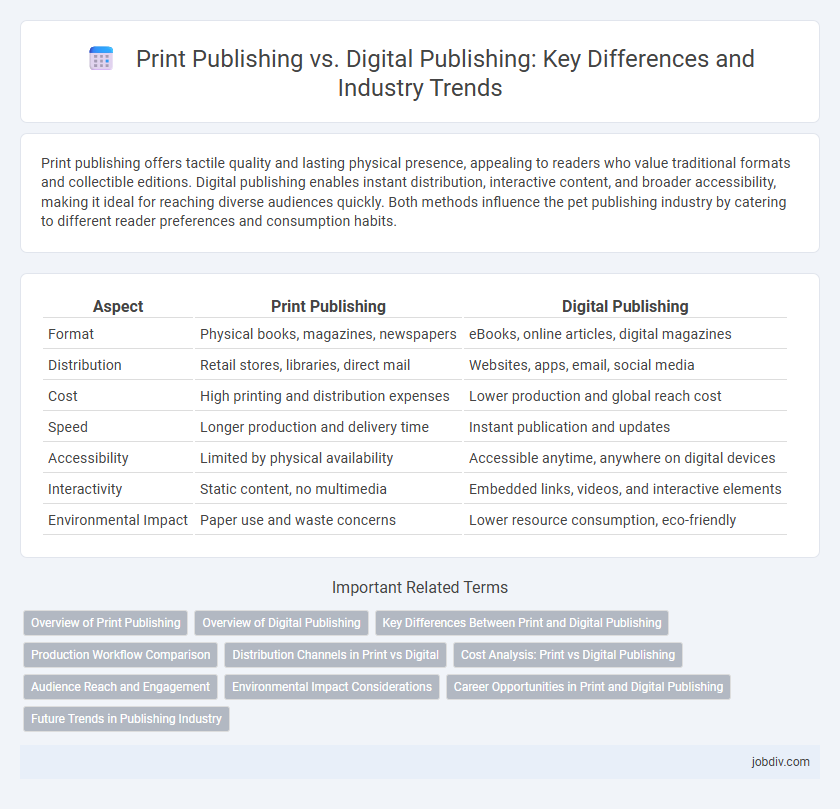Print publishing offers tactile quality and lasting physical presence, appealing to readers who value traditional formats and collectible editions. Digital publishing enables instant distribution, interactive content, and broader accessibility, making it ideal for reaching diverse audiences quickly. Both methods influence the pet publishing industry by catering to different reader preferences and consumption habits.
Table of Comparison
| Aspect | Print Publishing | Digital Publishing |
|---|---|---|
| Format | Physical books, magazines, newspapers | eBooks, online articles, digital magazines |
| Distribution | Retail stores, libraries, direct mail | Websites, apps, email, social media |
| Cost | High printing and distribution expenses | Lower production and global reach cost |
| Speed | Longer production and delivery time | Instant publication and updates |
| Accessibility | Limited by physical availability | Accessible anytime, anywhere on digital devices |
| Interactivity | Static content, no multimedia | Embedded links, videos, and interactive elements |
| Environmental Impact | Paper use and waste concerns | Lower resource consumption, eco-friendly |
Overview of Print Publishing
Print publishing involves producing physical books, magazines, newspapers, and other materials using traditional printing techniques such as offset or digital printing presses. This method ensures tactile engagement, lasting physical presence, and high-quality imagery, often preferred for its credibility and collectible value. Despite the rise of digital alternatives, print publishing maintains significant market share in academic, literary, and specialty markets due to its durability and reader preference for tangible content.
Overview of Digital Publishing
Digital publishing leverages online platforms to distribute content rapidly and globally, reducing production costs compared to traditional print publishing. It utilizes multimedia elements such as videos, interactive graphics, and hyperlinks to enhance reader engagement and accessibility. The growing adoption of e-books, websites, and mobile apps exemplifies the shift towards digital formats, which offer real-time analytics and customized user experiences.
Key Differences Between Print and Digital Publishing
Print publishing involves physical distribution of books, magazines, and newspapers, emphasizing tactile quality and long-term shelf presence, while digital publishing offers instant global access through electronic devices, enabling multimedia integration and real-time updates. Print media tends to have higher production and distribution costs, whereas digital publishing reduces expenses and supports interactive content, analytics, and customizable user experience. Audience engagement in digital publishing is enhanced by social sharing, searchability, and personalized recommendations, contrasting with print's reliance on traditional marketing and physical sales points.
Production Workflow Comparison
Print publishing involves a linear production workflow with stages including content creation, editing, design, printing, and physical distribution, requiring precise coordination of tangible materials and longer lead times. Digital publishing offers an agile workflow with real-time content updates, automated editing tools, instant online distribution, and multimedia integration, significantly reducing production cycles. Efficient management of metadata, file formats, and version control distinguishes digital workflows from the more rigid processes of print production.
Distribution Channels in Print vs Digital
Print publishing primarily relies on traditional distribution channels such as bookstores, newsstands, and direct mail, limiting reach to physical locations. Digital publishing leverages online platforms, e-readers, and mobile apps, enabling instant global distribution and accessibility. This shift drastically reduces costs while expanding audience engagement and tracking capabilities.
Cost Analysis: Print vs Digital Publishing
Print publishing incurs higher upfront costs due to expenses related to paper, ink, printing presses, and physical distribution logistics. Digital publishing significantly reduces these costs by eliminating physical materials and leveraging online platforms, though it requires investment in software, website maintenance, and digital marketing. Overall, digital publishing offers a more scalable and cost-efficient model, particularly benefiting independent authors and small publishers with limited budgets.
Audience Reach and Engagement
Print publishing offers tangible and collectible content, appealing to niche audiences who value physical media, but its reach is limited by geographic distribution and production costs. Digital publishing enables instant global access and interactive features like multimedia and hyperlinks, significantly increasing audience engagement and real-time feedback. The scalability and data analytics in digital platforms provide publishers with precise insights to tailor content, maximizing reader retention and broadening demographic reach.
Environmental Impact Considerations
Print publishing generates significant carbon emissions due to paper production, ink use, and transportation, contributing to deforestation and waste. Digital publishing reduces physical resource consumption and waste but involves energy-intensive data centers and electronic device manufacturing with environmental costs. Evaluating the environmental impact requires considering lifecycle emissions, resource extraction, and potential for reuse or recycling in both print and digital formats.
Career Opportunities in Print and Digital Publishing
Print publishing offers career opportunities in editorial roles, graphic design, production management, and distribution, emphasizing traditional skills in book layout and print technology. Digital publishing careers are rapidly growing, focusing on content strategy, digital marketing, web design, and data analytics to optimize online readership and engagement. Both sectors demand adaptability, but digital publishing increasingly requires expertise in SEO, multimedia content creation, and emerging digital platforms.
Future Trends in Publishing Industry
Print publishing continues to evolve with sustainable materials and personalized print-on-demand services gaining traction, while digital publishing leverages AI-driven content curation, immersive multimedia, and blockchain for rights management. Emerging trends emphasize seamless integration of augmented reality and virtual reality to enhance reader engagement across platforms. The future publishing industry will prioritize hybrid models that combine tactile print experiences with dynamic digital interactivity to meet diverse consumer preferences.
Print Publishing vs Digital Publishing Infographic

 jobdiv.com
jobdiv.com